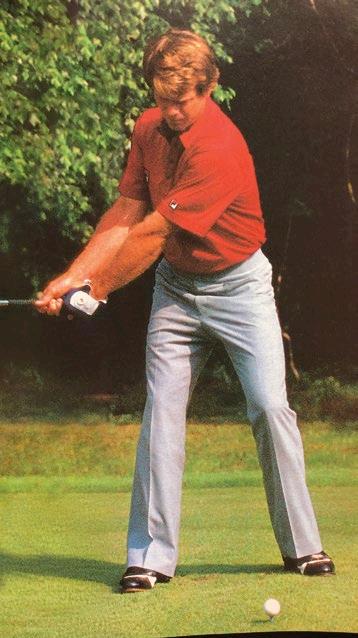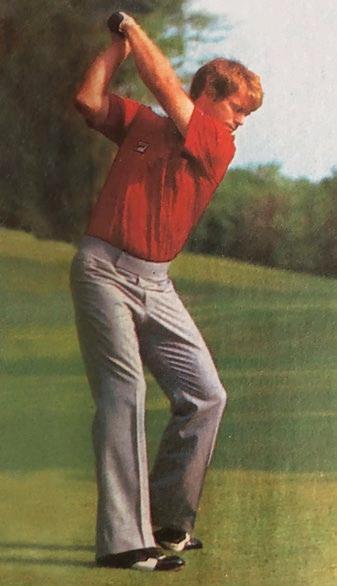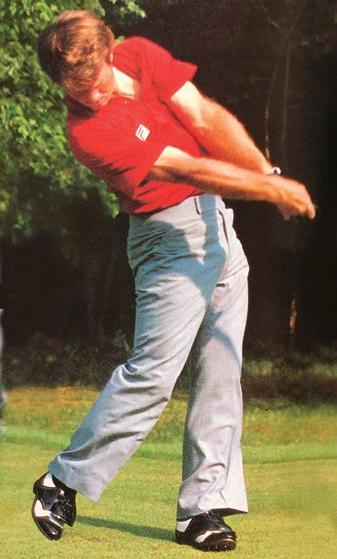
12 minute read
Tom Watson
What You Can Learn From My Swing I’ll walk you through it in nine steps
by tom watson
Ihave always enjoyed studying and comparing sequence photographs of golf swings. I’ve learned from poring over pictures of the swings of Sam Snead and Ben Hogan, for example, and then relating them to my swing. I like to hear what great players think about and feel before and during their swings.
In the next nine pages, we’ll look at stop-action photos of my swing from two camera angles, face-on and down the target line. I picked pictures that show me at what I consider to be the crucial stages of the swing, and my commentary accompanies each photograph.
Essentially, I tried to make major points that can apply to your swing as well as mine. Since there are as many golf swings as there are sets of golfers’ fingerprints, it would be presumptuous to suggest that you just out-and-out copy my swing—not to mention silly. It could cause more damage than benefit.
But I strongly believe in a few fundamentals that underlie my swing and could help yours. I’m talking about factors like posture, balance and left-side control, and I want to show you how I adhere to them throughout my swing.
A problem with sequence photographs is that they
freeze the motion, and you tend to talk about each photo separately rather than within the context of an overall, flowing swing. The reality is that a golf swing is greater than the sum of its parts. (I don’t know if Euclid said that, but if he didn’t, he should have.) You can’t guide your body and the club through a series of mechanical positions and get good results. You have to make a free pass at the ball, and you can do that only if you build the right kind of continuity—both conceptual and physical—into your swing. Sam Snead thinks of his swing flowing like oil. I like that.
In the next several pages, I’m going to hammer several times at key features of my swing—like a body tilt and centre of gravity that remain steady from address all the way to the follow-through. I’m also going to offer definitions— such as one for pausing at the top of the swing—that might sound different but prove to be very useful.
Before we begin, I should stress that all this type of analysis is predominantly for the armchair and the practice range. The worst thing you can do is go out for a round of golf with 17 swing thoughts buzzing through your head like fighter planes. On the course, I employ only one thought: a takeaway thought to get the swing started properly. After that, everything that happens is based on prior preparation or is a reaction.
A good golf swing is a complicated set of movements that must be precisely timed to work with any consistency, and you don’t master it by looking at pictures. But it is based on a few simple rudiments that anyone of basically sound body and mind should be able to master with a little attention and effort. Anybody who can count to two can play this game: you swing the club up and you swing it down. It’s that easy.
1Most golfers lose their balance easily during the swing, because they don’t start in balance. You must set up in balance to swing in balance. Working from the ground up, the insides of my feet are about even with the outsides of my shoulders— you can go a little wider, but I wouldn’t advise getting narrower or you’re apt to sway. My weight is toward the balls of my feet, not on my toes or heels, and distributed about
establish a good centre of gravity at address
50-50 left and right. The ball is off my left heel. (You can go a couple inches farther forward hitting a driver, but I wouldn’t put it back much.) My stance is just about square. It would be more open with shorter clubs. My knees are slightly flexed. I’m bent from the waist—I like to feel like my fanny is sticking out some. My arms are hanging at their lowest point, which is where they’ll want to return at impact. I try to keep tension out of my forearms—through the whole swing. Tight muscles are weak muscles. I try to be soft with my entire right side at address, so I can put my left side in command and make a good turn away from the ball. I grip more firmly with my left hand than my right. Notice the tilt of my back. It will remain pretty much constant throughout the swing, and my head won’t bob. My head and upper body are behind the ball—could be a bit more, actually. I want my centre of gravity directly between my feet. I want to keep that centre of gravity stable as I swing.


left arm creates extension on backswing
3The left arm continues to dominate. I’m well extended because I started back with my left side. By extension, I mean not using the hands too early in the swing; creating a wide swing arc with the left arm. If I can do that and keep the tilt of my back I started with, I shouldn’t have any trouble on the backswing. Left-side control. My right side remains passive. My right elbow is still soft, pointing at my hip. My right side never gets in the way as I turn. It folds under and submits to the leadership of the left side. Arnold Palmer is the perfect example of a steady head. I’m keeping a good, steady head here. Later in this sequence, we’ll come to the mirror image of this extended position on the through-swing.
left arm and club move away as one
2I waggle the club away from the ball twice before I start my swing to break up the tension and prepare my muscles for the takeaway. I think, One-two-go. Starting the swing, my only feeling is that the left side is pushing the club back—my entire left side. This is where left-side control in the swing begins. The thought that works best for me is that the left arm and the club move away from the ball as a unit. It’s pretty much one piece from my left shoulder to the ball. The club moves straight back on the target line for 12 inches. Then it starts to move inside and up as the shoulders turn, but I’m not conscious of it. My thought is to push the club straight back from the ball with my left arm. It’s my only conscious thought on the course swinging. My upper body remains stabilised. The angle of my back is unchanged. I want to turn around my spine—around the back of my neck. Left-side control. That’s what we see here.


with left-side control, a long swing can work
5At the top of my swing, my upper body continues to be tilted at the same angle I started with. My back is to the target. I don’t recommend going this far with the club— it’s below parallel, and I’d prefer it to be dead parallel to the ground or just short of it. At least I have some room to play with when old age catches up to me and shortens my swing. It would be worse to cut off the backswing prematurely and rush down. As long as the left side is in control, and mine is in this picture, you can get away with dipping below parallel. Don January does, and Ben Hogan did in the early part of his career. You don’t see it too well here, because my arm’s in the way in the down-theline view, but my club is pointing at the target. Again, my centre of gravity is about where it started, and my weight hasn’t gone to the outside of my right foot. The right side has to stay planted, with the right knee retaining that original flex.
taking the fear out of turning fully
4I’m still turning, getting my back to the target. Most people are afraid to make a full enough turn. Where am I?, they worry. They aren’t planted well enough on the right side. My centre of gravity hasn’t changed much from what it was at address. Maybe it’s shifted a little to my right, but that isn’t bad. The thing you don’t want to do is shift your centre of gravity to your left. My upper body is still over the ball, and I’ve retained the tilt of my back. My right knee hasn’t stiffened—it has remained flexed—and that’s crucial to a comfortable turn. My left heel has come off the ground, which facilitates a good turn, and I just let that happen. It replants when I start back down. The right side is still getting out of the way but now is starting to help lift the club. My left side is still solidly in control, though.


i feel everything starting down together
6I want to change directions at the top of the swing as if the club were a pendulum. It should be going at the same speed just before I get to the top and just as I start down. That’s my definition of a pause at the top. I want to feel everything working together in the downswing: arms, club, hips, legs. If anything, I’ve made too quick a move from the top in this particular swing, due to overswinging going back. My lower body has started forward before my arms, and the club is releasing already. I wish my arms were eight inches farther down. But I’m not in bad shape because, again, my centre of gravity is the same, my left side is still leading, and the tilt of my back has held.

keep hips and arms in timing through the ball
7This is a good, solid left-side impact position. My right side is not yet fully extended. I can hit as hard as I want with my right side, because my left side is out ahead. I’m really a little too far out of the way with my hips, but a positive point is that I’ve cleared my left side so my arms can swing down and through. If the hips turn, the left arm and side can keep leading. You can’t slide and slide with the hips—they have to unwind and turn. You have to let them release around, almost level. If you can keep your hips and arms in timing, you’ll get where you need to be. I’m releasing the club by rotating my forearms. My centre of gravity is still about the same, even though I got a little ahead of myself with my left hip. The angle of my upper body has been retained and is staying behind the ball. As for my lower body, I’d prefer to have my position in the previous photo at impact. Sam Snead would almost be hitting it from there, and he may have a perfect golf swing. This impact position has a good, firm look of the left side, almost what it was at address.

the right arm finally extends going through
8This is the reverse- C position you hear so much about, and I don’t like it or recommend it. It’s hard on your back. I look this way because I started down from the top a little too quickly. I have to pull back with my upper body to get my arms and the club on line. I’d much prefer to be taller, with my upper body more over the ball—where it was before—and my left arm a little more broken down. With this swing, I could push the ball out to the right. This is the companion photo to the third one in the sequence, which showed my left arm creating extension on the backswing. The right arm is extending here for the first time, as the left was earlier. It should swing right out at the target, then come back inside the line. Happily, my left side still has not relinquished its leadership in the swing, and my lower body has moved enough to counterbalance the backward movement of my upper body and keep my centre of gravity about the same. And the angle of my back is close to what it’s been throughout. As I’ve said, that’s important.

finish in balance—as i started
9I started the swing in good balance, and despite my hurried move at the top, I have finished in good balance and maintained my centre of gravity. It’s moved a little left as my weight has shifted onto my left side, but only to my initial ball position. I’ve maintained my back tilt, too, and my left side is in control all the way. I’m facing the target and I’ve rolled over to the outside of my left foot—that’s good balance in the follow-through. Summing up, I overswung a little and my legs started forward too soon, but the fundamental constants that run through the swing are good: the tilt of my upper body, the maintaining of my centre of gravity and the left-side control. Those principles I recommend to you without reservation, along with thoughtful practice. And consider having your swing photographed. What you’re doing, and what you think you’re doing, can be two very different things. Good luck and good swinging!









